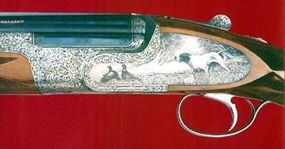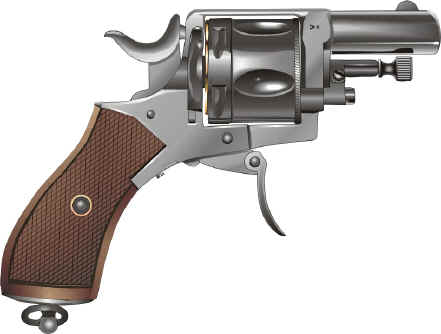
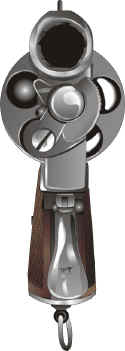
A little bit of
technical
Among the wide variety of firearms, and particularly handguns, semi-automatic
pistols are surely not, by far, the most technically understood. Not to speak of
the fairly frequent confusion between pistols and revolvers.
In this section, will be laid down some technical basis to clarify what is a
semi-automatic pistol and how it functions. And first of all, by opposition, you
will find hereafter a first picture representing an old Belgian "bulldog"
revolver chambering an obsolete .38 black powder car
tridge. This kind of small pocket handgun, with a folding trigger, was very
frequent at the end of the 19th century when semi-automatic pistols were yet to
be produced. As you can see a revolver bears a revolving cylinder drilled out of
chambers to accomodate cartridges. When you face a revolver you can immediately
see if it is or not loaded as the bullets' face is exposed. It is a quite
interesting "advantage" that does not occur when facing a pistol. Even if facing
any one of them, anyway, does not inspire confidence.
 |
 |
Semi-automatic pistols do not possess a revolving cylinder.
Generally, the ammunitions are contained in a movable magazine which, in most
cases, is slid in the pistol's butt. It is therefore rather difficult to know if
a pistol is loaded with a magazine, and moreover, if this latter really includes
cartridges. Not to speak of the uncertainty about the real presence of a
cartridge in the barrel's chamber, as a pistol can hold a full magazine in the
butt without a cartridge effectively chambered. Many things to be understood for
a layman, and many things that make the semi-automatic pistol more dangerous.
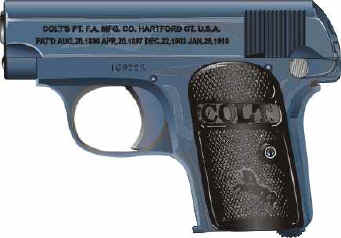
As one can see on the pistol hereover pictured (Colt model 1908), the barrel is
most often not exposed and surrounded by a moving part : the slide. To chamber a
cartridge, it is mandatory to first draw the slide back to its rearmost
position, by gripping it through its serrations, and let it slam forward under
the recoil spring pressure. When moving back to its initial position, the
breech's face (being an integral part of the slide) strips a cartridge out the
magazine and pushes it in the barrel's chamber. The pistol is then ready for
firing. At each shoot, the rearward movement of the slide is induced by the
gazes pressure against the breech face through the cartridge case. The cartridge
rechambering is automatically performed during the firing cycle. Why then the
"semi-automatic" term? Technically, an "automatic" firing occurs when cartridges
are loaded in a continuous stream as long as the trigger is kept under the
finger's pressure, like a machinegun for instance. A semi-automatic firearm
operates shoot by shoot, and the shooter has to release his finger between each
one. Generally, "automatic" pistols are in fact "semi-automatic", but this
latter term is seemingly quite few in use (probably too long) when speaking
about this firearms category, except by specialists who want to be clearly
understood by an exacting audience.
When observing the semi-automatic pistols functioning, one can point out many
mechanical principles which are all the more sophisticated that the cartridge
becomes powerful. There are some differences in the general strength and
mechanical disposition if a pistol has to overcome the power of a .25 ACP
cartridge or cope with the potent .45 ACP. As soon as we approach the .38 (9 mm)
caliber, it is hazardous to oppose the slide weight only to the gazes pressure.
This is approximately at this cross point that well-known firearm designers
proposed technical solutions that characterize their genius. Anyone initiated in
the field may recognise at once a Browning or Walther firearm type, simply by
the presence of technical options that were created by these inventors. For
instance, the Beretta 92 pistol encloses a pure Walther P38 locking device even
if conserving many of the external traditional Beretta pistol's features.
Among the most original systems was, no doubt, the toggle lock initiated by Hugo
Borchardt and greatly improved by Georg Luger. The Luger pistol, in its achieved
form, date back to 1898 and remained in service in Germany until the end of
World War II. Swiss kept it as a regulation sidearm for many more years.
When a cartridge releases a pressure nearing or passing one Ton/cm2, it must be
understood that the slide can be considered as a second missile oriented toward
the shooter's face. To deal with that somewhat dangerous issue there is only one
solution : maintain the slide and barrel jointly locked for a portion of time
that allows the bullet to leave the barrel and the pressure consequently drop to
zero.
In the Luger pistol, the breech's locking is warranted by a toggle mechanism.
The barrel is screwed in a long U shaped barrel extension. Inside this extension
can travel a mobile breech block pinned to the forward link of the toggle. The
rear link being fixed to the extension through a large pin. So, only the breech
block can move horizontally between the extension branches inside the limits of
the toggle folding.
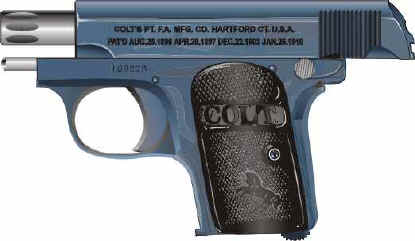
In closing position, that is to say with the two toggle links flat, the
"barrel-extension-breech-toggle" acts as one closed bound unit. This state of
thing continues until the center of the mid-axis remains under the line that
joins the centers of the external axes (the forward one linked to the breech
block and the rearward one linked to the barrel extension, as depicted
hereafter). Upon firing, under the burning gazes thrust, the whole bound unit
moves quickly rearward. During this move the bullet has enough time to leave the
barrel. The pressure then drops instantly to zero. Quite evidently the moving
parts keep an important momentum. After a 6 mm move, the toggle knobs are
reaching a slope corresponding to the frame upper profile (green arrow).
Progressively, as the knobs climb the slope, the central axis center goes up to
finally reach a position (over the line of the two other axes) where the toggle
is mechanically induced to fold, and consecutively draw the breechblock backward
through its front link connection. The extraction and ejection of the case take
place at this moment.When the toggle has terminated its maximum folding, the
recoil spring acts through a specific link to drive the toggle forward and close
lock the pistol. The breech face strips a fresh round out of the magazine and
chambers it. The firing cycle is then achieved.This whole complicated mechanism
has only one vocation : overcome the heavy pressure released by the cartridge.
This system here depicted is typical of the Luger pistol, the .45 Colt Browning
pistol encloses another system, as does the Walther P38 or the 1907 Roth Steyr,
but the goal remains the same : to lock the barrel and the slide for a short
while in order for the bullet to leave the barrel and the pressure to drop to
zero.
